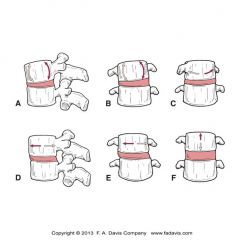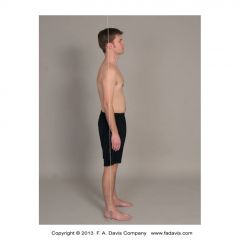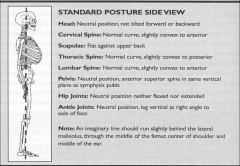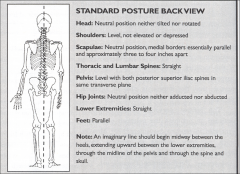![]()
![]()
![]()
Use LEFT and RIGHT arrow keys to navigate between flashcards;
Use UP and DOWN arrow keys to flip the card;
H to show hint;
A reads text to speech;
16 Cards in this Set
- Front
- Back
|
Posture (define)
|
Alignment of body parts whether upright, sitting or recumbent
|
|
|
Basis of many musculoskeletal pain syndromes?
|
Postural impairments
|
|
|
Affects of Impaired Posture?
(list 2) |
Microtrauma from:
Overuse -athletes -repetitive motion during work -holding a single posture for a long time Poor Technique: -weekend warrior Poor posture increases the strain on supporting structures, making the system less efficient |
|
|
Examination of Posture
|
Traditionally examined in standing and sitting
-or any position patient frequently assumes Different phases of life -walking -gait |
|
|
Standard Posture
|
Refers to ideal posture
-have to think of both dynamic (muscles ) and inert structure (joint capsules….) Muscle provide Dynamic counterforces Inert (bone, ligament): provide passive tension Compare patient’s posture to the standard -Any deviations are considered impairments of posture |
|
|
Curves of the Spine
|
Four curves of the adult spine
-Two primary or posterior curves -Curves found babies -Convex to posterior -Thoracic, sacral areas – can have kyphosis Two compensatory or anterior curves -Named: as infant learn to lift ed and stand, those forces have to go the other way -Found in cervical, lumbar spines, the areas where you have lordosis In an upright posture the line of gravity should transect the spinal curves |
|
|
Motions of the Spine
|

Six degrees of motion – from text
A. Flexion – Extension B. Side bending (lateral flexion) C. Rotation (ant. of vertebral body) F. Compression – Distraction D/E. Lateral shear |
|
|
Line of Gravity
|
Places stress on structures responsible for maintaining upright posture
-stabe, line of gravity should fall thru aixs of rotation Weight bearing joints -continually challenged for stability and efficient movement -sway 12 degress (text 4cm) |
|
|
Postural Alignment
|

Where of line of gravity should fall
Ankle: slightly anterior to lateral malleous stability: by plantar flexors, (gastroc/solieus, more solius b/c its more of a stabilizer mm) Knee: anterior to knee joint, but posterior to patella stability: ACL, posterior capsule of knee, calves and hamstring muscles Hip: b/c of posturial sway varies, but should go thru greater trocantur stability: sway changes it, but either hip flexiors/extensors Trunk -Midway between the back and the abdomen -Midway between front and back of the chest -Should pass through the bodies of the lumbar and cervical vertebrae Head -Through the lobe of the ear In a back view of the patient right and left halves should be symmetrical -medial border of scapula ~3 inches from spine |
|
|
Standard Posture (side view of skeleton)
|

CORRECTION: ANKLE: SHOULD BE ANTERIOR TO LATERAL MALLEOLUS
|
|
|
Standard Posture (back view of skeleton)
|

|
|
|
Effects of Impaired Posture
|
Maybe not inflammatory response, mechanical problem but less likely a pathology or disease
Pain -Stress on ligaments, joint capsules, nerves, etc. -Pain without injury and overuse syndromes Muscle Endurance -Injuries more likely after repetitive activity -Muscles become either short or long -Described as long muscles being weak, short being tight |
|
|
Pain Syndromes Due to Impaired Posture
|
Postural Fault
Postural Pain Syndrome Postural Dysfunction |
|
|
Postural Fault
|
Anthying that devieates from normal alignment
Not true strucutal impairment Can be whole sytsem, or like a single segment |
|
|
Postural Pain Syndrome
|
-Occurs due to mechanical stresses from same posterior over time
-Pain relieved by activity b/c getting out of that posture -Early on will not see deficit with strength -Hyperbobility can cause |
|
|
Postural Dysfunction
|
Adaptive shortening of muscle, weakness, can be caused by poor postural habits, or caused by some trauma or surgery (contractions or adhesions)
Shortened tissues will cause pain as try to elongate them |

